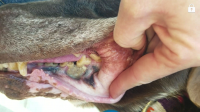With that kind of extreme craving--of your cat for liver--
maybe that points you in a good direction.
Maybe you could look into a liquid vitamin A (like the one haidut sells)
and apply it to your cat's gums...?
I mean, as I've said with all these anti-carcinogens we know about regarding human use,
research how it works with cats.
But it is possible your cat might benefit from a walloping dosage in this situation.
Peat has talked about using massive doses on himself, temporarily.
I think in that context he was talking about when he was getting a lot of sunlight.
And then--another context--when he had an oral pre-cancerous growth.
haidut (it's always him, isn't it!) had, I think, a post which talked about how,
in human use,
vitamin A toxicity is much exaggerated...you might look into that as one data point.
But I do realize that care must be taken with specific cat toxicities which different from human.
maybe that points you in a good direction.
Maybe you could look into a liquid vitamin A (like the one haidut sells)
and apply it to your cat's gums...?
I mean, as I've said with all these anti-carcinogens we know about regarding human use,
research how it works with cats.
But it is possible your cat might benefit from a walloping dosage in this situation.
Peat has talked about using massive doses on himself, temporarily.
I think in that context he was talking about when he was getting a lot of sunlight.
And then--another context--when he had an oral pre-cancerous growth.
haidut (it's always him, isn't it!) had, I think, a post which talked about how,
in human use,
vitamin A toxicity is much exaggerated...you might look into that as one data point.
But I do realize that care must be taken with specific cat toxicities which different from human.

